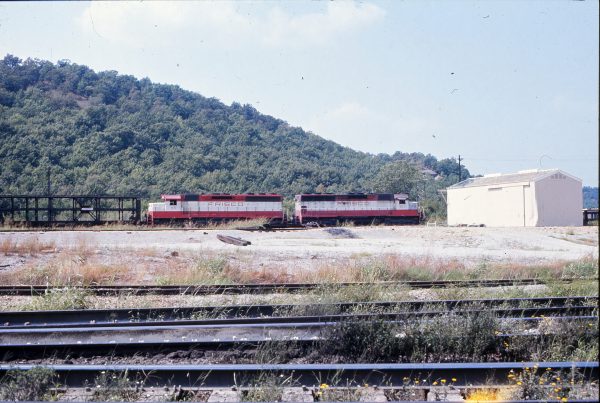Category Archives: CA Collection
2-8-2 4207
SD45s 907 and 915
E8A Meet at Springfield, Missouri
S-4 298
SW7 304

SW7 304 St. Louis, Missouri (EVDA Slides).
Location is St. Louis, Missouri.
The switch engine is on the north side of Lindenwood Yard. It is moving west toward the locomotive service tracks and diesel shop area. It has just passed under the Arsenal Street bridge. An interesting detail seen through the rear window on the fireman’s side is the clear plastic trash bag. It is hanging from one of the safety rails protecting the window on the inside of the cab.
To the north, beyond the tree line in the upper right of the image, down in the valley is the River des Peres (River of the Fathers). From its origin in Creve Coeur (heartbreak) the 9.3 mile river initially flows southwest before turning southeast just west of the Frisco yard. It empties into the Mississippi River just south of the city limits of St. Louis.
View is looking southwest.
Special thanks to Mark Davidson.
E8A 2017 (Pensive)
SW1500 357
F3A 5012
U30B 839

U30B 839 Tulsa, Oklahoma in September 1972.
Location is Tulsa, Oklahoma.
The locomotives are in the Mechanical Department’s service tracks area at Cherokee Yard, mile post 426.9. The service tracks and diesel shop will be replaced with new facilities during capital improvements in the yard in 1976. Note the lettering on the forward equipment box door under the cab floor beside the nose that indicates “KNUCKLE SUPPLIES INSIDE”.
SLSF 839 was one of eight units (SLSF 836-843) in the railroad’s second order from General Electric’s for its model U30B. The Frisco would ultimately own 31 units of this model. They were purchased in five groups between 1968 and 1975. The first and second group orders (SLSF 832-843) were phase IIb units. The third and fourth groups (SLSF 844-857) were phase IIg1 units. The fifth order (SLSF 858-862) were phase IIh1 units. The term “phase” refers to car body spotting characteristics used by modelers and rail fans. “Phase” was not a term used by the manufacturer or railroad.
In the background to the right of the subject locomotive is the former steam locomotive roundhouse that was converted to a diesel shop. The nose of an unidentified number EMD SD45 is also on the right. Note the distinctive cast round F medallion marking the locomotive’s front. In the distance to the left is an unidentified number Fairbanks-Morse H-12-44 switch engine locomotive. This is one of the four H-12-44 (SLSF 282-285) units owned by the Frisco. These units were equipped for multiple unit operation on the Cherokee Yard hump. They would only MU cab-to-cab.
Above the nose of the H-12-44 in the far distance across the Arkansas River are two high rise buildings in downtown Tulsa. The shorter building is the Cities Service Oil and Gas Corporation building. Opened in 1971, the corporate office tower has 28 floors and stands 388 feet tall. Its address is 110 West 7th Street, Tulsa, OK 74119-1031. Today it is known by its address as the 110 West 7th Building.
Further northeast is the taller First Place Tower. It is under construction at the time of the photograph and will be opened during 1973. The office tower has 41 floors and stands 516 feet tall. Its address is 15 East 5th Street, Tulsa, OK 74103-4346. Today it is the 3rd tallest building in the city and 4th tallest in the state.
View is looking northeast.
Special thanks to Mark Davidson.








